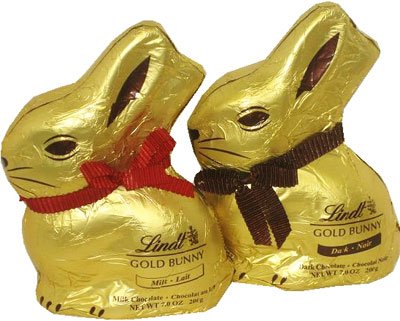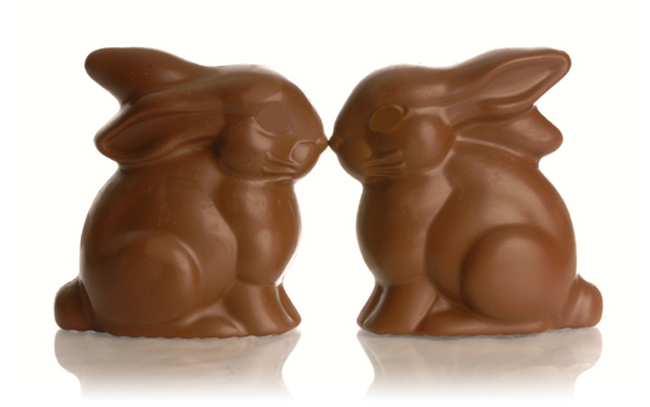Reflections on Easter Bunnies - Chocolate and Otherwise
With close family in younger years dressing up as Easter witches the clue is to know when to exercise discretion..
-
 The tradition of the Easter rabbit can be traced back to pagan Europe. Spring is a season for new birth, fertility, and growth, it made sense early on to link spring with rabbits. Germans, not Swedes, get the credit for creating the first rabbit-shaped sweets but we looked to Switzerland for the just right shape and taste.
The tradition of the Easter rabbit can be traced back to pagan Europe. Spring is a season for new birth, fertility, and growth, it made sense early on to link spring with rabbits. Germans, not Swedes, get the credit for creating the first rabbit-shaped sweets but we looked to Switzerland for the just right shape and taste. -
-
As a child, I took great pleasure in devouring the Easter bunny. I have photographic proof that I was ravenous and dug into the chocolate ear of at least one. I also recall huge cardboard eggs, their two halves lacquered on the outside and spilling candy like benign shrapnel all over the place if I was not careful. The inside of the eggs contained some irritating green grass that was not real and took up valuable space that might have been reserved for a greater harvest of sweets.
-
 They say your technique for eating Easter bunnies has a lot to say about personality secrets. In case you start with the the ears you're practical, organized and traditional. You value security and are extremely loyal. Your greatest weakness is impatience but you're honest and kind to a fault. (No, we lack scientific data for this)
They say your technique for eating Easter bunnies has a lot to say about personality secrets. In case you start with the the ears you're practical, organized and traditional. You value security and are extremely loyal. Your greatest weakness is impatience but you're honest and kind to a fault. (No, we lack scientific data for this) -
-
I have memories of my brother dressing up as a påskkärring (Easter witch), each cheek a target of red, as I enjoyed practicing sibling rivalry and making all sorts of comments to him in his seasonal costume. I have photographic evidence of this escapade also, but as we age we learn to exercise discretion.
-
Much later, as an adult, I was exposed to Easter egg hunts in America. I still have not figured out the attraction of this pursuit. First of all, the eggs are not the hardboiled eggs I remember as a child, but plastic canisters filled with candy or other substitutes of what chickens on the farm used to lay in Sweden. The pleasure in those eggs was also learning from my mother that the eggs had to be boiled with exactitude and also finding the green ring surrounding the solidified yellow of the yolk. I enjoyed — and was simultaneously irritated by — peeling the eggs. Often the shells came off in very small, sharp intervals of calcium, providing just enough challenge to get at the food without too much work, like eating artichokes, a rare delicacy in my childhood.
-
To get back to Easter egg hunts, I wonder how some parents can allow their children to bulldoze smaller children in an effort to get eggs. Or worse, parents getting in on the game, blocking a child from having a lucky hunt. To me, that is like a grownup taking a baseball from a child at a game in the stadium. Yes, what a way to show the practice of the golden rule, be it during sporting events or the tour de eggs during this special season we call Easter.
-
But is this season special or has it been demystified and become a secular holiday with not even a momentary thought of Jesus? The colorful illustration in my Swedish children's Bible to this day accompanies me, and if I did not understand completely or even remotely the suffering of Christ and his rebirth, the celebratory moments of Christianity, I am still at least haunted by the picture of how big Jesus was and how small the donkey was that he rode — and how I felt sorry for the animal.
-
Now I try to avoid being exposed to Easter sales and Easter egg hunt-turned-recruiting events of many churches, though I marvel, reluctantly (if it is possible to do so), at the Easter bunny. A mere mortal breathes with some difficulty inside a costume, and as he sweats up a storm, though not of Biblical magnitude, even adults want to have their photo taken with this anthropomorphized Easter bunny with his stupid pink ears and grey fur, a smile pasted on artificial skin frozen like that of a model or particular newscaster chirpily offering quickie news.
-
One of the reasons I am fascinated by the Easter bunny, besides the smaller thought of what eggs have to do with the cousin of the hare, is that the Easter bunny appears to be less an icon of controversy than Santa Claus during the other big, ostensibly Christian holiday. Lutherans, Baptists, Catholics, Jews and a whole array of people seem to get along with the Easter bunny without bringing thoughts of a violation of the spirit of the season and what its religious affiliation should be and exactly how it should be expressed and celebrated. It could be the Easter bunny is non-denominational, but sitting outside in our unseasonably warm March day in the mid-80s, I thought the Easter bunny is Catholic. He is Jewish. He is also Lutheran and Baptist.
-
As I record the Easter bunny's religious affiliation, it occurs to me that the Easter bunny is perhaps female and not male. Why do we assume the Easter bunny is male? It certainly is difficult to discern any sex characteristics when looking at the hare's cousin's colorful, glittering fatigues ... or, if aluminum is not the dress of choice, a pink or otherwise eye-catching color of gloss that can directly be consumed without disrobing the effigy of chocolate. At least Santa has a rather large beard for gender identification purposes and we don't consume his body made out of chocolate.
-
Yes, I am not a fan of holidays, Easter included, because the religious significance has been eroded from so many and the commercial accoutrements have fossilized the sensibilities of people to buy what is often crappy candy — overly sweet, with not enough cocoa in the chocolate, or simply a sugary mix to create eggs that are larger than Jelly Beans. It is, as they say, a free country, so while I 'm not particularly religious in any conventional or strict sense, what I am going to do on these marked calendar days is re-familiarize myself with the passages from the Bible that have to do with Easter. That will be my entertainment this year.
-
Glad påsk!
-
Ulf Kirchdorfer
-
-
